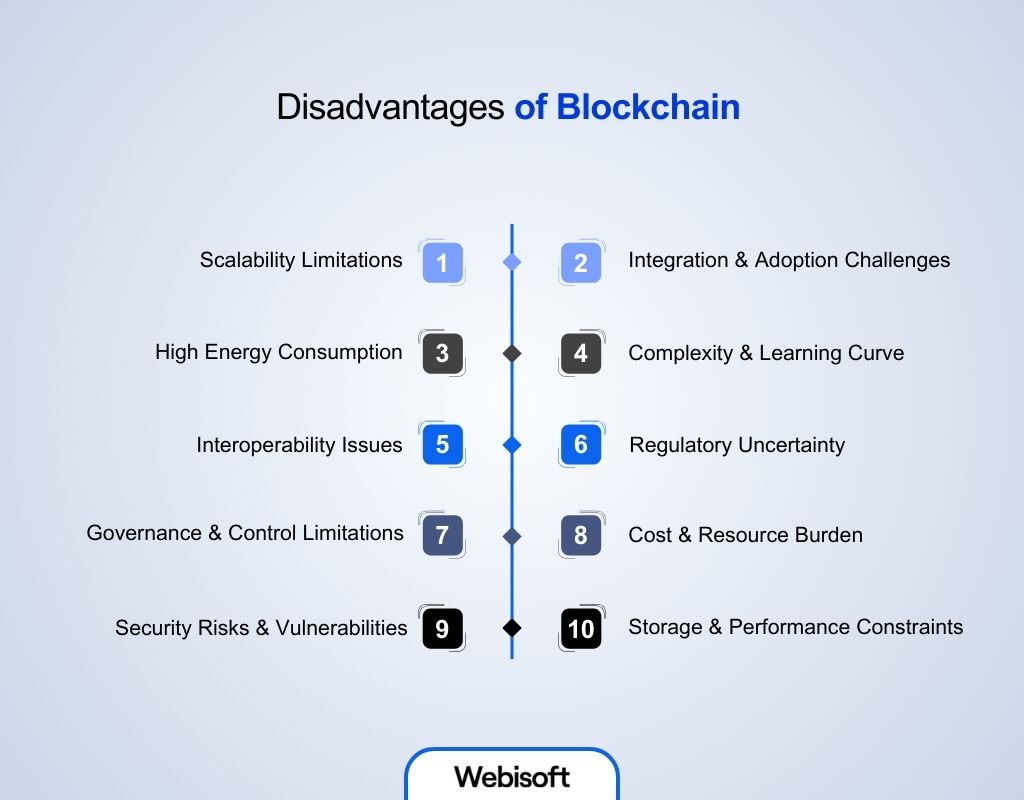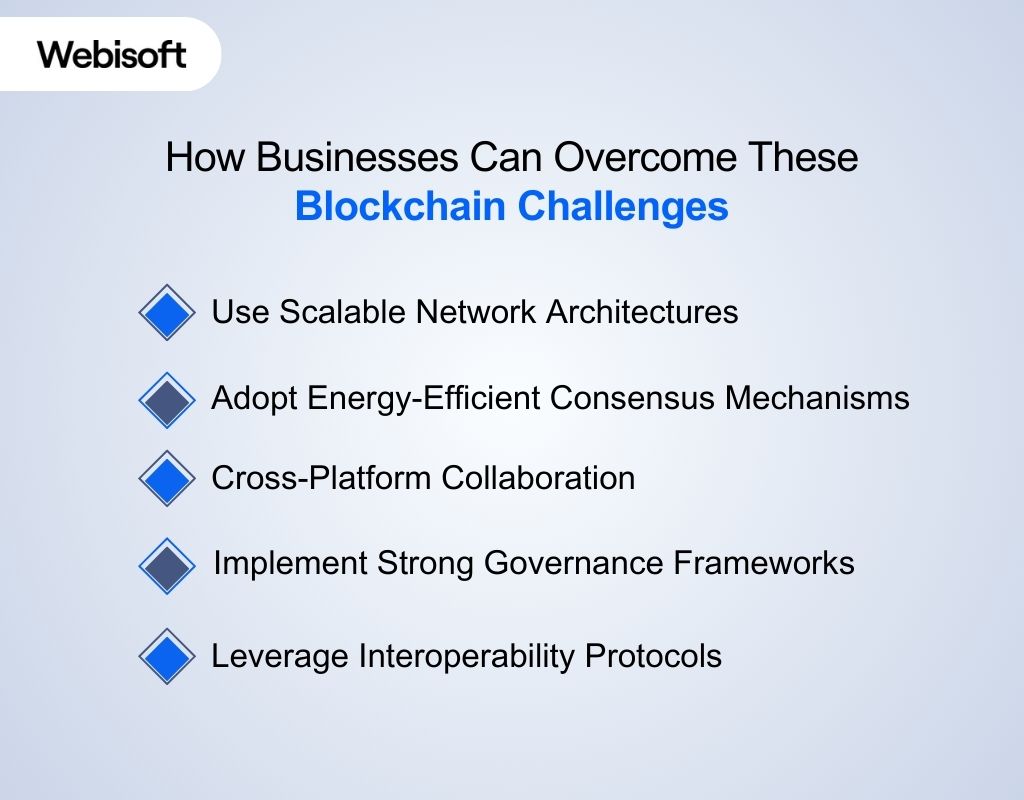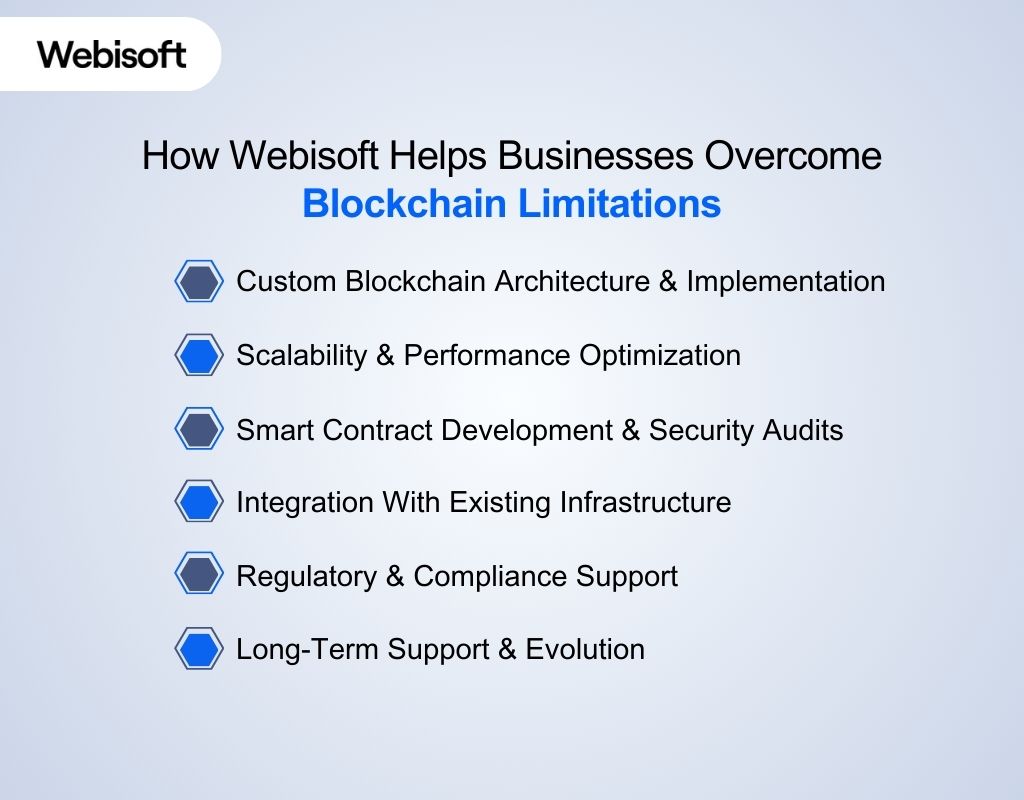16 Disadvantages of Blockchain: Limitations and Challenges
- BLOG
- Blockchain
- December 8, 2025
Blockchain is widely praised for its transparency, security, and decentralization, but it is far from perfect. Understanding the Disadvantages of Blockchain is essential for anyone planning to build, integrate, or adopt blockchain systems.
From scalability bottlenecks to energy-heavy consensus models, the technology faces real constraints that impact its performance and practicality. This guide breaks down the most significant blockchain limitations, explains why they occur, and explores how they affect real-world adoption.
Whether you’re a business evaluating risks or a developer looking for clarity, you’ll gain a clear perspective on the blockchain challenges that shape this technology today.
Contents
- 1 What Is Blockchain?
- 2 Strengthen your blockchain ecosystem with expert audit support from Webisoft.
- 3 Disadvantages of Blockchain
- 3.1 Scalability Limitations
- 3.2 Integration & Adoption Challenges
- 3.3 High Energy Consumption
- 3.4 Complexity & Learning Curve
- 3.5 Interoperability Issues
- 3.6 Regulatory Uncertainty
- 3.7 Governance & Control Limitations
- 3.8 Cost & Resource Burden
- 3.9 Security Risks & Vulnerabilities
- 3.10 Storage & Performance Constraints
- 4 How Businesses Can Overcome These Blockchain Challenges
- 5 Choosing the Right Multi-Chain Framework
- 6 The Future of Blockchain Despite Its Limitations
- 7 How Webisoft Helps Businesses Overcome Blockchain Limitations
- 8 Strengthen your blockchain ecosystem with expert audit support from Webisoft.
- 9 Final Note
- 10 Frequently Asked Questions
What Is Blockchain?
Blockchain is a decentralized digital ledger that records information across a distributed network rather than in a single central database. Each block contains verified transactions and is cryptographically linked to the previous one, creating a tamper-resistant chain of data.
Because altering past entries is nearly impossible, blockchain provides strong transparency and security for various applications. Although best known for powering cryptocurrencies, blockchain has expanded into industries like finance, supply chain, healthcare, and identity management.
Its ability to reduce intermediaries, automate verification, and create permanent records makes it a compelling technology, but it also introduces several blockchain limitations that contribute to the broader Disadvantages of Blockchain discussed later in this guide.
Strengthen your blockchain ecosystem with expert audit support from Webisoft.
Get tailored audit reviews, remediation guidance, and high-level technical support for secure and reliable blockchain operations.
Disadvantages of Blockchain
 Blockchain delivers transparency, trust, and automation, but these strengths also introduce meaningful constraints. Understanding the Disadvantages of Blockchain helps businesses evaluate when the technology fits and when traditional systems may work better. Below are the major blockchain limitations affecting real-world adoption.
Blockchain delivers transparency, trust, and automation, but these strengths also introduce meaningful constraints. Understanding the Disadvantages of Blockchain helps businesses evaluate when the technology fits and when traditional systems may work better. Below are the major blockchain limitations affecting real-world adoption.
Scalability Limitations
Most blockchains struggle to handle large transaction volumes efficiently. As more users join a network, transaction speeds slow down, fees rise, and overall performance drops. This is especially visible in major networks like Bitcoin and Ethereum, where block size limits and congestion impact usability.
Although solutions like sharding and Layer-2 scaling exist, scalability remains one of the most persistent blockchain challenges.
Integration & Adoption Challenges
Integrating blockchain into existing systems often requires rethinking database structures, workflows, and IT infrastructure. Organizations must adapt legacy systems or replace them entirely, which can be costly and time-consuming. Additionally, blockchain development requires specialized skills that many teams lack. These hurdles create significant enterprise blockchain challenges that slow down adoption.
High Energy Consumption
Blockchains using Proof of Work (PoW) consume large amounts of electricity due to intensive computational requirements. This raises environmental concerns and increases operational costs for miners and businesses. Even though newer models like Proof of Stake reduce energy usage, the perception of blockchain being energy-heavy remains one of the well-known drawbacks of blockchain technology.
Complexity & Learning Curve
Blockchain introduces new technical concepts such as distributed ledgers, smart contracts, consensus models, and cryptographic keys. For businesses and beginners, understanding these components can be difficult without technical expertise. This steep learning curve contributes to overall issues with blockchain adoption and slows down decision-making within organizations.
Interoperability Issues
Different blockchain networks often operate independently with unique protocols, making cross-chain communication difficult. Without strong interoperability, assets and data cannot move freely between platforms. This creates fragmentation in the blockchain ecosystem and limits opportunities for unified enterprise solutions or multi-chain applications.
Regulatory Uncertainty
Blockchain is still evolving, and regulations vary dramatically between countries. Governments continue to debate how to classify digital assets, enforce taxation, and apply compliance rules like AML and KYC. This regulatory uncertainty creates hesitation among businesses and investors who need clarity before committing to long-term blockchain strategies.
Governance & Control Limitations
Blockchain’s decentralized nature limits the authority of any single entity to make changes or override decisions. While this increases fairness and security, it becomes a challenge for enterprises that require controlled environments. Disagreements among participants can lead to forks, fractured communities, or stalled upgrades, all of which impact network stability.
Cost & Resource Burden
Despite reducing intermediary fees, blockchain can be expensive to implement. Costs include hiring developers, building infrastructure, deploying nodes, and maintaining the network. These expenses make blockchain harder to adopt for small and mid-sized companies with limited resources.
Security Risks & Vulnerabilities
Although blockchain itself is secure, its surrounding ecosystem is not immune to attacks. Smart contract bugs, exchange breaches, phishing schemes, and poorly configured nodes can expose users to financial loss.
Strengthening wallet security through advanced methods for securing private keys can reduce vulnerabilities linked to unauthorized access. Smaller networks also face risks like 51% attacks, where a malicious actor gains majority control and manipulates transactions, a critical cons of blockchain often overlooked.
Storage & Performance Constraints
As blockchains grow, their data requirements increase significantly. Each full node must store the entire transaction history, which can reach hundreds of gigabytes. This makes long-term storage costly and limits the number of users willing to run full nodes. Growing storage needs impact transaction performance, validation speed, and overall network accessibility.
How Businesses Can Overcome These Blockchain Challenges
 Although blockchain introduces several issues with blockchain and operational hurdles, many of these obstacles can be mitigated with the right strategy and expert blockchain consulting services. Businesses adopting blockchain today are focusing on solutions that strengthen performance, reduce cost, and improve long-term sustainability.
Although blockchain introduces several issues with blockchain and operational hurdles, many of these obstacles can be mitigated with the right strategy and expert blockchain consulting services. Businesses adopting blockchain today are focusing on solutions that strengthen performance, reduce cost, and improve long-term sustainability.
Use Scalable Network Architectures
To address congestion and scalability concerns, companies often turn to Layer-2 solutions, sharding techniques, or optimized consensus models. These approaches improve throughput without compromising security. For enterprise environments, permissioned blockchains can also offer more predictable performance.
Adopt Energy-Efficient Consensus Mechanisms
As sustainability becomes a priority, organizations are shifting away from energy-intensive Proof of Work systems. Proof of Stake, Proof of Authority, and hybrid models significantly reduce power consumption, helping businesses overcome one of the biggest blockchain challenges.
Cross-Platform Collaboration for Easier Blockchain Integration
Cross-platform collaboration helps businesses integrate blockchain solutions smoothly across existing tools and workflows. By enabling systems to communicate in real time, teams reduce friction during deployment and maintain consistency across multiple environments. This approach strengthens coordination, simplifies updates, and supports a more unified operational structure.
Implement Strong Governance Frameworks
Clear governance rules help prevent network disputes, reduce fork risks, and streamline decision-making. Many enterprises now create formal governance models with defined roles, voting mechanisms, and upgrade procedures to maintain stability.
Leverage Interoperability Protocols
Cross-chain communication tools, interoperability frameworks, and standardized APIs allow different blockchain networks to work together. This helps reduce fragmentation and supports broader adoption across ecosystems and industries.
Choosing the Right Multi-Chain Framework
 Businesses exploring blockchain adoption often evaluate networks that support interoperability and cross-chain communication. Selecting the right framework influences scalability, ecosystem growth, and long-term integration options.
Businesses exploring blockchain adoption often evaluate networks that support interoperability and cross-chain communication. Selecting the right framework influences scalability, ecosystem growth, and long-term integration options.
Comparing leading interoperability platforms such as Cosmos vs Polkadot helps organizations understand how different multi-chain models affect performance, governance, and development flexibility.
Strengthen Security & Smart Contract Auditing
Security risks can be reduced through smart contract audits, node hardening, penetration testing, and continuous monitoring. These measures protect networks from bugs, exploits, and vulnerabilities, some of the most frequently cited cons of blockchain.
Use Hybrid or Off-Chain Storage Models
To overcome storage and performance constraints, businesses often combine on-chain verification with off-chain data storage. This approach ensures scalability while keeping the blockchain lightweight and efficient.
Blockchain adoption doesn’t have to feel overwhelming. Webisoft helps businesses navigate technical hurdles with clear strategy, secure development, and tailored execution. Start your blockchain journey with expert support from Webisoft.
The Future of Blockchain Despite Its Limitations
 Even with the known blockchain limitations, blockchain adoption continues to grow as new innovations address many of today’s challenges. The future of blockchain is shaped by technologies and practices that enhance efficiency, reduce cost, and strengthen global trust in decentralized systems.
Even with the known blockchain limitations, blockchain adoption continues to grow as new innovations address many of today’s challenges. The future of blockchain is shaped by technologies and practices that enhance efficiency, reduce cost, and strengthen global trust in decentralized systems.
Advancements in Scalability Solutions
Next-generation scaling techniques, such as rollups, parallelized execution, and multi-chain ecosystems promise significantly faster transactions and reduced congestion. These improvements will make blockchain suitable for high-volume, real-time applications.
Improved Interoperability Across Networks
Future networks will place a strong emphasis on seamless cross-chain communication. Interoperability protocols, bridges, and unified standards will allow assets and data to move freely between blockchains, unlocking larger and more interconnected digital ecosystems.
Greater Regulatory Clarity
As governments establish clearer frameworks for digital assets, more enterprises will adopt blockchain confidently. Stable regulations reduce uncertainty and help address many of the current enterprise blockchain challenges related to compliance and oversight.
Growth of Zero-Knowledge Technologies
Zero-knowledge proofs (ZKPs) allow sensitive data to remain private while still being verifiable. This innovation bridges the gap between transparency and confidentiality and will be essential for enterprise applications.
Sustainable Blockchain Models
Eco-friendly consensus mechanisms and carbon-neutral blockchain initiatives will continue to gain momentum. These trends directly respond to global concerns around the environmental impact and the drawbacks of blockchain technology seen today.
Modernizing Internal Systems Intranet Improvements
Businesses updating their digital infrastructure often combine blockchain solutions with stronger internal communication systems. Enhancing platforms like a company intranet helps streamline workflows, while blockchain adds secure data handling and transparent record-keeping. Together, these upgrades improve collaboration, reduce errors, and support smoother enterprise operations.
Mainstream Enterprise Adoption
Despite the Disadvantages of Blockchain, the technology is becoming more accessible, thanks to user-friendly development frameworks, modular architectures, and cloud-based blockchain services. As these tools evolve, businesses will adopt blockchain more easily and at lower cost.
How Webisoft Helps Businesses Overcome Blockchain Limitations
 Overcoming the complexities and structural barriers of blockchain doesn’t have to be overwhelming. Webisoft’s expertise helps businesses navigate these blockchain challenges with clarity, strategy, and reliable technical execution. Whether you’re exploring blockchain for the first time or optimizing an existing system, Webisoft provides end-to-end guidance tailored to your operational needs.
Overcoming the complexities and structural barriers of blockchain doesn’t have to be overwhelming. Webisoft’s expertise helps businesses navigate these blockchain challenges with clarity, strategy, and reliable technical execution. Whether you’re exploring blockchain for the first time or optimizing an existing system, Webisoft provides end-to-end guidance tailored to your operational needs.
Custom Blockchain Architecture & Implementation
Webisoft designs blockchain systems that match your business requirements, whether public, private, hybrid, or consortium-based. By aligning architecture with real-world use cases, we help you avoid unnecessary complexity and reduce long-term implementation barriers.
Scalability & Performance Optimization
Our team incorporates advanced scaling solutions such as Layer-2 networks, sharding, and efficient consensus mechanisms. These enhancements ensure that your blockchain application remains fast, responsive, and ready for growth.
Smart Contract Development & Security Audits
Webisoft builds secure, optimized smart contracts and performs in-depth audits to identify risks before deployment. These measures help prevent vulnerabilities, reduce operational risks, and create a safer environment for your users.
Integration With Existing Infrastructure
We ensure seamless integration between blockchain platforms and your current systems, reducing downtime and simplifying transitions. From ERP systems to APIs, our solutions ensure compatibility without adding unnecessary friction.
Regulatory & Compliance Support
As blockchain regulations evolve, businesses must stay aligned with legal expectations. Webisoft helps you navigate compliance complexities, supporting industries that face strict oversight such as finance, healthcare, and supply chain.
Long-Term Support & Evolution
Blockchain adoption doesn’t end at deployment. Webisoft provides ongoing maintenance, updates, and optimization services to keep your ecosystem secure, scalable, and aligned with new technology trends.
Strengthen your blockchain ecosystem with expert audit support from Webisoft.
Get tailored audit reviews, remediation guidance, and high-level technical support for secure and reliable blockchain operations.
Final Note
As blockchain continues evolving across industries, it’s important to understand both its strengths and its constraints. Exploring the Disadvantages of Blockchain gives businesses a realistic view of what to expect when implementing decentralized solutions.
Challenges around scalability, energy use, interoperability, and governance remain significant, yet ongoing innovations are steadily reducing these barriers. The future of blockchain is shaped by rapid improvements in scalability, regulatory clarity, sustainable consensus models, and enterprise-ready infrastructure.
With the right strategy and guidance, businesses can harness the advantages of blockchain while minimizing its limitations. As adoption grows, organizations that approach blockchain thoughtfully, with technical, operational, and compliance considerations in mind will be best positioned to unlock its full potential.
Frequently Asked Questions
What are the main Disadvantages of Blockchain?
The biggest disadvantages include scalability limits, high energy consumption, complex integrations, governance challenges, security risks in surrounding applications, and storage demands. These blockchain limitations affect how easily the technology can be adopted at scale.
Why is blockchain not always the best solution?
Blockchain is not ideal for situations requiring fast transactions, editable data, centralized control, or low-cost infrastructure. In such cases, the cons of blockchain outweigh the benefits, and traditional databases may be more efficient.
Is blockchain environmentally friendly?
Not always. Proof of Work systems consume large amounts of energy, contributing to one of the core drawbacks of blockchain technology. Newer consensus models like Proof of Stake significantly lower energy usage.
Why do enterprises struggle to adopt blockchain?
Businesses often face enterprise blockchain challenges such as high implementation costs, lack of technical expertise, integration complexity, and uncertain regulations. These factors slow down adoption despite the technology’s potential.
Can blockchain be regulated effectively?
Governments worldwide are developing clearer rules for digital assets, AML/KYC compliance, and blockchain-based services. Regulation is improving, but uncertainty still exists, affecting global adoption.


